1983 Porsche 911 Carrera 3.2 vs. 1993 Porsche 928 GTS Automatic
Back in 1983, when the Carrera 3.2 was launched, the 911’s future still hung in the balance — only a few years beforehand, Porsche heralded the 928 as the car projectedto take the brand into the next century. History, however, tells a different story...
Words Johnny Tipler
Photography Dan Sherwood
911 CARRERA 3.2WHY THIS EIGHTIES 911 IS A FAN FAVOURITE
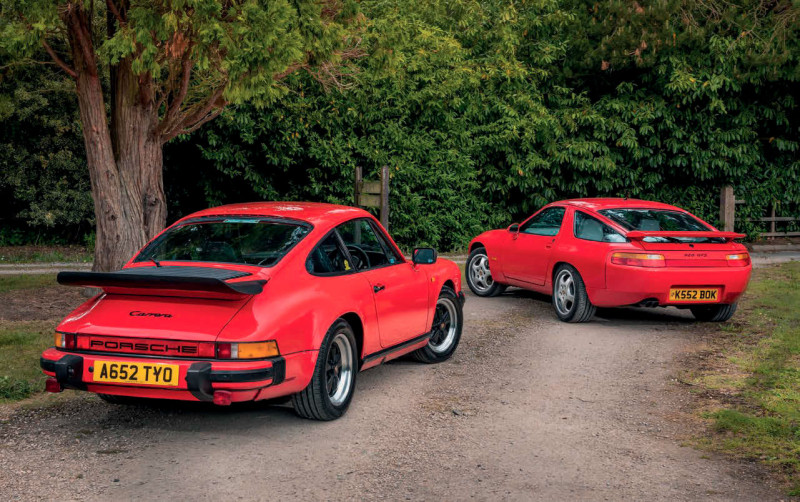
Porsche’s foray into the world of front-engined sports GTs lasted two decades, beginning with the 924 and ending with the cessation of the 928 and 968 in the 1995 model year. In 1970, when the 924 and 928 were in design, the writing looked to be on the wall for the 911 — its ongoing survival was a close-run thing. Porsche CEO, Ernst Fuhrmann, certainly thought front-engines were the way to go.
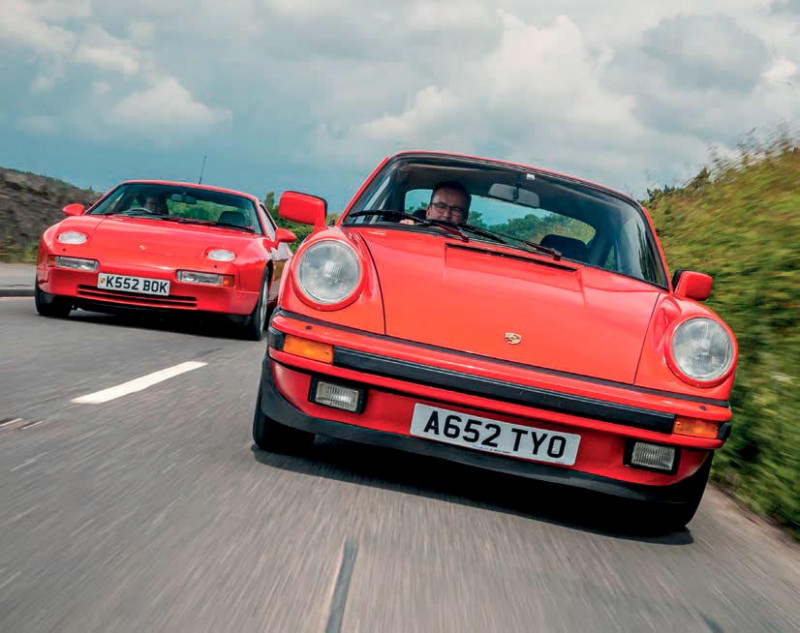
IT FEELS LIKE A MUSCLE CAR, IMMEDIATELY VERY POWERFUL, WITH AMAZING TORQUE AND ACCELERATION
Fuhrmann, the engineer responsible for the 356’s legendary Type 574 four-cam, was intent on forsaking the 911, no matter the fact he personally had a powerful legacy with rear-engined Porsches. Indeed, the 928 had been on the cards since 1968 and, in 1971, when Harm Lagaaij joined Anatole Lapine in Zuffenhausen’s design studio, the department’s drawing boards were full of renderings for front-engined GTs. Even then, car styling at Porsche was a pre-determined process calculated by defined market indicators. In 1981, however, new company boss, Peter Schutz, instigated the revitalisation of the Zuffenhausen plant and decreed the 911’s survival. He recognised the model’s burgeoning status as a classic and broadened the 911 line-up, yet his marketled philosophy also enabled Porsches front-engined range to flourish. He’s our hero, then.
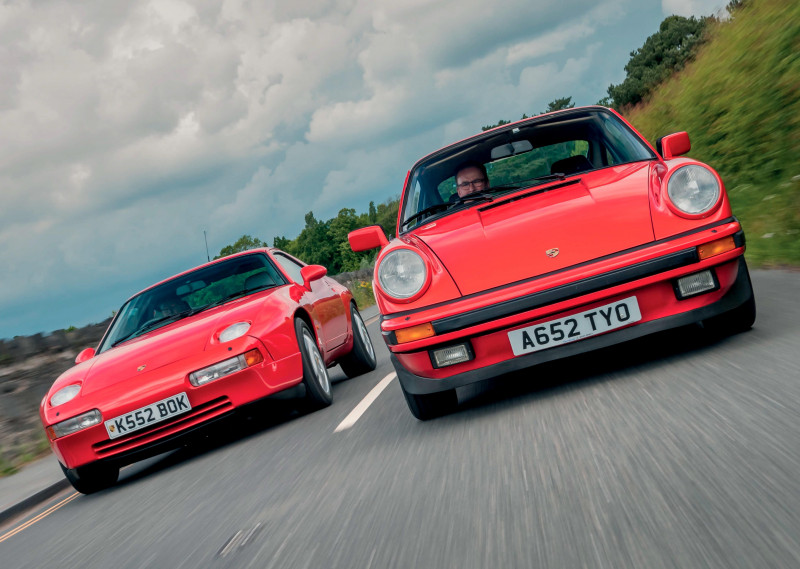
THE 911 HAD NOTCHED UP ALMOST A DECADE-AND-A-HALF’S WORTH OF COMPETITION SUCCESSES ACROSS THE BOARD
Forty-five years ago, the 928 was launched for the 1978 model-year at the 1977 Geneva Motor Show, promptly winning the coveted European Car of the Year award, an accolade normally scooped by saloon cars. And yet, in terms of Porsche’s front- and rear-engine configurations, there was an ongoing paradox, which was the vigorous and potent development of the 911 as a turbocharged race car, exemplified by the 934 and 935, the legacy of which spilled over into the 911 Turbo (930) road car. For the next fifteen years, the 911 and 928 were produced in tandem, with the 4.7-litre 928 S appearing in 1980 and matching the 930’s near 300bhp power output. The 928 S2 landed in 1984, bringing with it improved specification and a slight increase in engine output.
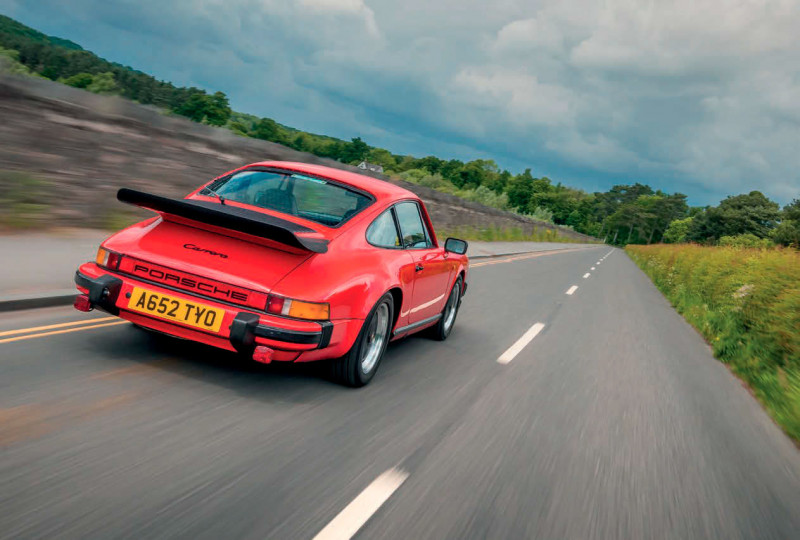
Two years later, the highly revised and facelifted five-litre 928 S4 arrived, joined in 1987 by the S4 Clubsport, a lightened version of the S4 intended for track use and only available in the USA and mainland Europe. This was followed by 1989’s 928 GT, a model available only with manual transmission. The S4 and GT were phased out in 1992, ushering in the ‘N Programme’ 928 GTS as the final evolution of the V8 supercar. It’s the model we have here. We’ve come to Loughborough in Leicestershire to visit Graham York, a Porsche buff and owner of both our feature cars, as well as a 996 Turbo, but we won’t go there — one water-cooled Porsche is quite enough for providing the context of this article. So, then, here we have two sports cars from different ends of the Porsche product spectrum. In today’s money, they’re worth about the same, leading prospective purchasers to question which is the better buy. Let’s find out.
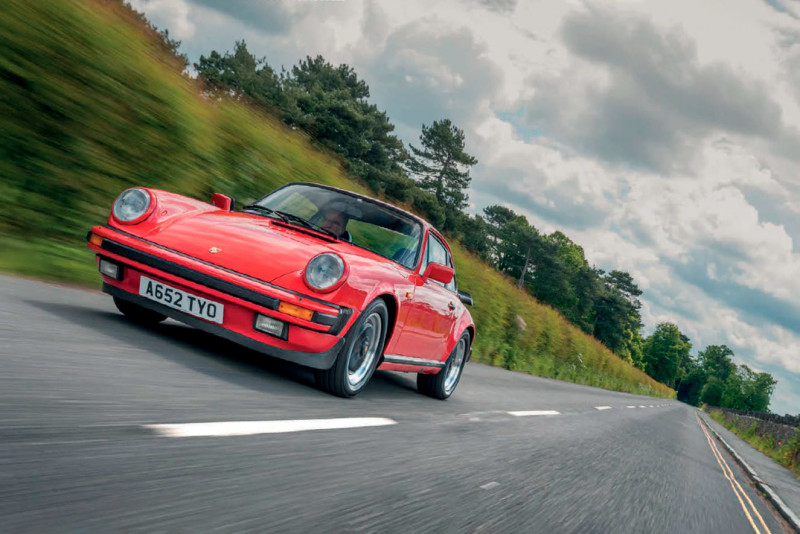
AIR AND WATER
Graham’s 1984 Carrera 3.2 (co-owned with his son-in-law, Jonathan Allcock) came first, acquired in 2011, nine years before his name appeared on the logbook of the 1993 928 GTS. Both cars are painted Guards Red. “I enjoy the different driving experiences,” he says. “One of these Porsches is a modern-feeling GT, the other is very analogue.” Which does he prefer? “It’s really about what you want out of the driving experience. If I was going to set off on a cross-continent dash, I’d take the 928. If I wanted to go up to the Highlands of Scotland and tackle tight twisties, I’d probably take the Carrera 3.2. They’re polar opposites.” And servicing? He has all three of his Porsches maintained by local marque specialist, Quorn Sports and Classics, located about six miles away from his home and well versed in both air- and water-cooled Porsches of all ages. With the assurance of Quorn’s spanner work, he’s driven the 911 to the Le Mans Classic twice, as well as to the south of France. “As a family, we’ve enjoyed some great journeys in this car. The only downside of the Carrera 3.2 is its heavy clutch. In other words, it’s not a particularly relaxing Porsche, but it’s incredibly rewarding to drive. You feel everything that’s going on, but you have to keep your wits about you. The gear change, for example, has to be slow and precise.
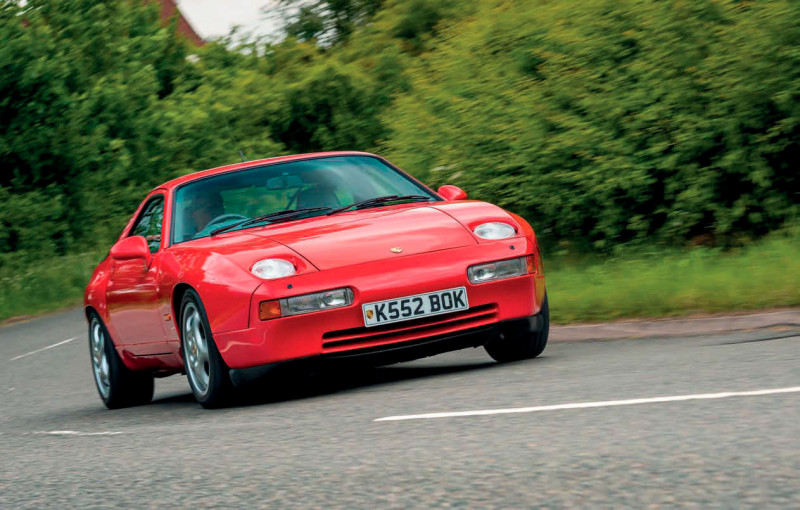
Everything about the controls keeps you on your toes, whereas the 928 GTS is a comfortable cruiser loaded with an automatic gearbox, meaning you just shift into drive mode and away you go.” It’s thought close to eighty percent of all 928s were shipped with automatic transmission, though the seldom seen 928 GT was equipped with a manual cog swapper only.
Graham has no doubt Porsche did the right thing by keeping the 911 alive. “I’ve driven many different 911s over the years,” he tells us. “They all have what I call a Porsche ‘feel’ about them, whereas the 928 is different in so many ways. It’s beautifully engineered, of course, and can be very rewarding, but it’s a big, heavy car. By comparison, the 911 always feels nimble. Sure, an air-cooled 911 can be skittish at the back in the damp. You certainly don’t get that sensation in a 928, but the Carrera 3.2 is much more of a traditional sports car.” If push came to shove, which would he hang on to? “It depends whether you’re keeping for investment purposes or for driving pleasure. If I was keeping for investment, I think the 928 has plenty of future growth, especially with renewed interest in the model as a consequence if this forty-fifth anniversary year. If I was keeping one or the other for those goose-bump driving moments, however, I’d keep hold of the Carrera 3.2.”
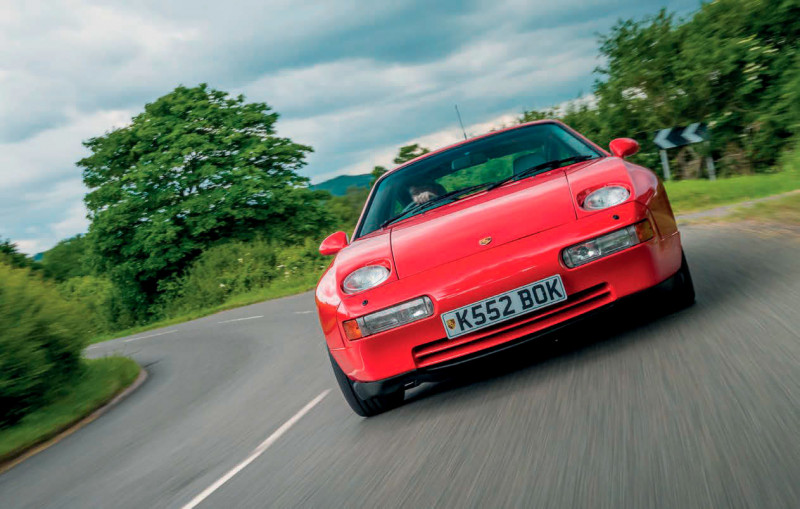
I know whereof he speaks. For five years, I did the school run in a Carrera 3.2, thirty-five miles each way, twice a day. The only way to make such a schedule pleasurable was to do it in a 911. Enough B-roads and backroads to fully appreciate the model’s lively and enlivening sportscar qualities, responding right on cue to a spot of right-foot pressure and arm twirling on the fairground-ride back-doubles. The Carrera 3.2 has solid build-quality and reliability to match. Mechanically, it’s pretty well bomb-proof and, indeed, surprisingly structurally resilient. I’d go so far as to say I think it’s probably a better-made 911 than the 964, plus the Carrera 3.2 combines some of the rawness of the classic long-bonnet 911’s ride and handling traits — although you have to be going very quickly or driving crazily to be able to reach back and touch the wildness of, say, a 2.2-litre 911 S — with most of the creature comforts you’d expect from Porsche products manufactured in the 1990s.
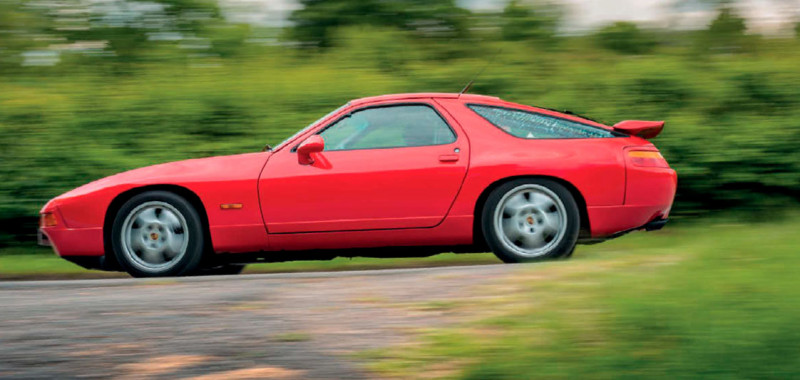
The Carrera 3.2 also serves well as a grand tourer, something Porsche will tell you is the 928’s stomping ground. My 3.2 transported our family-of-four overland to our gaff in Portugal on several occasions. Granted, the kids were little back then, but the car’s roof gutters enabled the fastening of a Thule top-box for maximum luggage-carting capability, and although airflow over the top of the car was somewhat compromised — the temperature gauge said so — it didn’t drastically interfere with aerodynamics. Who am I kidding? Of course it did. No more so than when my son, Alfie, fainted at Puebla de Sanabria truck stop, having been roasted due to sunshine blasting through the back window and excessive engine heat dissipated in the rear of the cabin. I couldn’t touch the metalwork where he’d been sitting. It really was that hot! Luckily, a douching with a bucket of cold water brought him around.
The Carrera 3.2 is, with hindsight, the bedrock of air-cooled 911 annals. In production for six years, it epitomises the 911 shape, arguably more so than the long-bonnet classics, and certainly more than the play-it-safe 964 and its successor, the 993, what with its shapely curves all rounded off. The Carrera 3.2 was available in Coupé, Targa and Cabriolet format, with Slant-nose, Speedster, Club Sport and SSE Super Sport spin-offs. You thus had a choice of configurations in which to enjoy the experience, open to the elements or not.
AROUND THE BEND
And what of the 3.2’s handling? As I’ve said before in these pages, on the move, all your senses come into play. The absence of power steering means everything is full-on and sensitive. Feedback is instantaneous — you feel exactly what the suspension is doing and where the car is going. Your reactions are honed to match. It’s not that you don’t get this with power assistance, you just experience it more directly. Left- or right-hooker, all 3.2s are hugely involving to drive, nowhere more so than twisty back roads. On a poorly surfaced B-road, the front wheels bubble over every undulation as they feel out the topography. It’s alive, a creature working out which path to take for best effect, and you are controlling it by light movements of the wheel as it bucks slightly in your fingers with each and every passing bump. As you go faster, the steering progressively loads up, the more physically demanding it becomes.
The Carrera 3.2 features relatively long gearing, both in 915 and G50 transmission formats, which matches with the slow and deliberate nature of the gearshift, as you go from one notch to another quite deliberately. You can’t just bang it through. It’s not ponderous, because you have to be precise about where you move the lever. Bring a 915 gearbox from fifth to fourth, for instance, and you have to be calculated about your movement, else you quickly graunch into reverse. Of course, it’s second nature before long. Put your foot down in fifth, and you can be sure this thing will deliver the power, although it’s not devastating. Better to drop a cog in an overtaking situation to be safe.
Equally, you notice how strongly the Carrera 3.2 pulls when you get up to the legal speed limit. It really delivers between 4,000rpm and 6,000rpm. Third gear overtaking on A-roads is stunningly fast, accompanied by that raucous flat-six bellowing as the revs scream towards 6,000rpm. The power builds relentlessly until you run out of road or come up on a back-marker. Conversely, this 911 will pull inexorably from 1,500rpm in top. You need to get your braking done first, ideally trail-braking up to a corner, although the stoppers are so powerful that an occasional stab will take off excess speed if you are travelling a tad too fast approaching a bend. You see, you drive the 3.2 through corners. You get the lock on early and steer it through, lock off a bit of oversteer, induced with the wheel, perhaps, but most likely by use of the throttle — off to make the front end tuck in, or on to drift out.
On back roads, you can drive the Carrera 3.2 by the seat of your pants, attacking rather than defensive, positive rather than passive. On a sweeping A-road, be sure you know what the limits are — both of the road and the car — to ensure you’re ready for the unexpected and have time to pull up or take avoiding action.
On a roundabout, this 911 just hangs on. You can put lock on and off, making the nose tuck in or out with the accelerator. On greasy rural lanes, bearing a patina of tractor muck, you can feel it sliding, and you teeter around bends on the point of breaking away. The thing is, it’s so sensitive, you can feel as much and be confident that, within reason, the car will carry on going around and not dispatch you into a hedge. Indeed, because this is a particularly strong 911 and the suspension is equally robust, you can rumble over potholes on a farm track and the car won’t bat an eyelid. Although it may not be the quickest Porsche point-to-point, the 3.2 is fun and rewarding to own and drive.
SHARK ATTACK
Lucky for us, the Zuffenhausen hierarchy knew this, too. In 1978, when the 928 was introduced, the Carrera 3.2’s predecessor, the 911 SC, was all heavy-duty concertina bumpers, the 911 not looking its prettiest. You’d probably have opted for a 928 purely on aesthetic grounds. Why did the ‘land shark’ not supersede the 911, then? Image? Tradition? Aspirant owner profile? Technological evolution through racing? The obvious absence of 928s in top-line competition probably says it all. Sure, a 928 S contested the 24 Hours of Le Mans twice, managing twenty-second overall in 1983, though the car was 62mph slower in a straight line than the Group C 956s.
Le Mans winner, Richard Attwood, competed in a Brumos 928 S at the 1984 24 Hours of Daytona and, more recently, ran an early 4.5-litre 928 in the Historic Sports Car Club’s ‘70s Road Sports series on behalf of Porsche Classic. None of this is to say the 928 couldn’t have been developed at Weissach into a viable contender, but by the time of the 928’s launch in 1978, the 911 had notched up almost a decade-and-a-half’s worth of competition successes across the board. The closest to a racing variant of the 928 is the previously mentioned Club Sport, examples of which were handed out to Porsche works drivers as company cars, most of them enjoying little more than the transcontinental commute between circuits during the 1980s.
Also, why rock the boat? Until the advent of the liquid-cooled 996 GT3, there was no need to. It pains me to say it, but the 924 Turbo and the 924 Carrera GT were a relative flash-in-the pan. We do the 928 a disservice, though, because it wasn’t conceived as a competition car. Rather, a comfortable, luxurious express for doing the long haul. Like the 911, it’s a two-plus-two and, as an example of sublime car design, Wolfgang Möbius and Tony Lapine’s styling is an absolute masterpiece. Lots of aluminium, such as the wings, doors and bonnet, and the ovoid “egg styling” — emphasised by integrated polyurethane bumpers — is amusingly echoed in the model’s pop-up headlights, which resemble half eggshells. The rear-three quarter windows are elongated (they’re longer than the door windows) and the flying-buttress rear three-quarter posts surrounding the greenhouse rear window enable the 928 to embrace more luggage than the Carrera 3.2.
Any 928 is a long-distance grand tourer, the embodiment of the original Grand Routiére concept born of Mediterranean journeys in the 1930s. This V8-powered Porsche makes regal progress in smooth and sedate fashion, totally appropriate to the bourgeoisie. Thinking back, the longest road trip I’ve done in a 928 is from Silverstone to the Nürburgring and back. I thought it would be a hoot to drive a 928 GT nine-hundred-and-twenty-eight miles (careful plotting ascertained this was the distance between the two iconic racetracks). Channel crossed, as my photographer and I purred eastward on autoroute and autobahn, I couldn’t help thinking, if any car merits an automatic shift, it is the 928, so torquey is the Porsche V8, even though ratios are quite widely spaced, certainly in the manual-only 928 GT. In fact, it pulled from virtually a standstill in fifth. Normally, I appreciate a manual shift, but a car like this suits an automatic, and you rightly expect it to do the work for you.
For a coupé, the 928 possesses a roomy cabin — I could stretch my left leg out behind the pedals, which was welcome on a long run. The steering was nicely weighted, while the brakes required a certain amount of pumping to get them up to scratch. I reflect this car was possibly not in the best of nick at the time. Nevertheless, at high speed, it was imperious and dominant of other traffic. At 100mph, it was rock-solid. It’s easy to see where the transcontinental express allusion comes from, because it is up here at these speeds that the 928 comes into its own. This is the definitive autobahn-stormer, and only its front-engined successors, the Cayenne and Panamera, do it better. Fuel economy? This wasn’t much of an issue back then, unlike today, when the voluminous eighty-six-litre fuel tank would cost a packet to brim. A bit of a shocker? Maybe, but at a steady 70-80mph, the 928 I was driving averaged 25-30mpg, which enabled considerable intervals between refuelling stops.
DIFFERENT STROKES
Graham’s GTS represents Porsche’s final salvo in its espousal of front-engined grand touring cars. The V8 was redesigned with a longer-stroke crank, lifting capacity to 5,397cc, with four-valve heads, LH Jetronic fuel injection, resonance induction system and electronic ignition. A stronger five-speed manual gearbox with its own oil cooler and differential-driven oil pump was offered, as was the popular four-speed automatic, with the Porsche Sperr Differential (PSD) limited-slip differential standard across the board. The engine bay is chock-full of 5.4-litre V8, with intake plenum inscribed ‘32V’ to indicate, er, thirty-two valves. There’s a strut brace fronted by a huge water radiator and oil cooler right in the front. The engine is located with the weight just behind the front axle, and, of course, the transaxle assembly is at the rear, which is fundamental to equalising the 928’s weight distribution.
Separated by almost a decade, performance comparisons between the 928 GTS and Carrera 3.2 are less relevant to our theme than the chasm between their on-road behaviour, in terms of ride and handling, as well as comfort and attitude. The 911 is invigorating and entertaining, the 928 a serene limousine. Or am I missing something? Let’s take a ride. I survey the GTS’s spacecraft switchgear and fire up the lusty V8. Out on the open road, when I kick down the accelerator, it downshifts and takes off. When I back off, it reverts, dropping back in line to fourth, but then, a little bit of right foot pressure, and it’s off again. On Rutland’s seductive ups and downs, crests and dips, the GTS’s chassis and suspension is clearly very well sorted as I flick from one turn to another. The 928’s sporting ability belies its size.
Preconceptions this Porsche is going to be big and ponderous fly away. There’s a fluency to the drive, insofar as the number of controls I have to operate is reduced to just the accelerator pedal and steering wheel. It feels like a muscle car, immediately very powerful, with amazing torque and acceleration. Considering the 928 is such a sizeable beast, it’s displaying secure and compliant handling, firm ride, and very good road holding. It’s remarkably controllable as I twist the power-assisted wheel from lock to lock, the luxury liner easing gamely into shape, ready for the next corner. The sports car aspect of the GTS is just beginning to reveal itself. This is certainly not an ‘old man’s car’ (a sort of life consolation prize for when the 911 no longer entices or enthrals). The GTS is a powerful cocoon of car for the money. This is key — the cost of buying a 928 GTS is on par with what ownership of a decent Carrera 3.2 will set you back you right now. Sure, the 928 does things differently to the 911, but therein lies much of the V8- propelled Porsche’s unique appeal. If you’re torn between two very different classic Porsches sitting at the same price point, however, you don’t need to hedge your bets: if your heart rules your head, you’ll take the Carrera 3.2.
Above Currently hovering at the same price point, the Carrera 3.2 and the 928 GTS present two very different options for anyone wanting to get into Porsche ownership. Above Pop-up headlights make any car cool and were a trait of all Porsches in the manufacturer’s transaxle family of cars, though only the 928 and 968 featured exposed lamps.
Above The 928 was Porsche’s first ‘clean sheet’ design, meaning it was a model which didn’t have its roots in any other, though there’s no denying the Corvette influence brought to the party by stylists, Anatole Lapine and Wolfgang Möbius.
Above GTS interior is as comfortable as they come and features a superb ‘wraparound’ dashboard extending into the door cards. Above The original 928 was launched with a 4.5-litre V8, which had grown to a thirty-two valve 5.4-litre unit by the time of the GTS, the only 928 available during its time in Porsche dealer showrooms.
Above G-series body styling, complete with ‘accordion’ impact bumpers, lasted fifteen years, discontinuing with the arrival of the 964.
Above Carrera 3.2 interior is quintessentially 911, very functional, but not particularly evolved from the first iteration of the evergreen flagship Porsche product, whereas the 928’s cabin feels positively space-age by comparison.
Above A Carrera 3.2 finished in Guards Red was the ultimate ‘pin-up Porsche’ for the 1980s, adorning many bedroom and office walls.
How time flies. If there’s one thing to make an automotive enthusiast feel old, it’s a significant anniversary of a car or event, the launch of which sticks firmly in the mind as a recent occurrence. The twentyfifth birthday of the Boxster in 2021 is a prime example of what I’m getting at, as is this year’s two-decade anniversary for the Le Mans Classic. 2022 also marks another significant milestone for Porsche fans — forty-five years of 928.
Now, this is Classic Porsche magazine, and as such, we usually only point our cameras at air-cooled cars carrying the Stuttgart crest (if kettles are your thing, subscribe to our sister title, 911 & Porsche World, the world’s bestselling monthly Porsche magazine). That said, with renewed interest in the Zuffenhausen ‘land shark’ as a consequence of its forty-fifth trip around the sun — done in the lap of luxury, what with it being a super-opulent V8 grand tourer — we reasoned comparable cost between the last-of-line 928 GTS and the earlier Carrera 3.2 may well present something of a conundrum to prospective purchasers wanting to experience Porsche ownership with a set budget in mind. Air or water? Classic 911 or something entirely different from the Porsche stable?
In this issue, we’ve brought together samecoloured examples of both models in the interests of ‘compare and contrast’. Talking of colour, the vibrant shades Porsche applied to its products in decades past — as opposed to the popularity of grey, black, silver and white in more recent times — is one of the hallmarks of the classic Porsche scene, but eye-popping paintwork isn’t exclusive to our favourite manufacturer’s historic road cars. Indeed, the Porsche motorsport department turned out some extraordinary-looking racing machines in years gone by, with some of the liveries worn going on to become more famous than the drivers parading them around the world’s bestloved circuits. Across the following pages, we’ve examined ten brilliant examples of Porsche battle dress. Let us know which is your favourite. On your marks. Get set. Go!


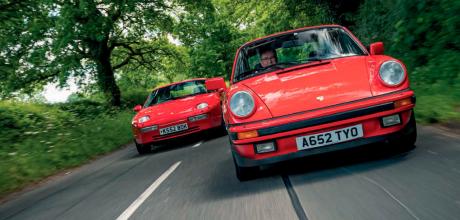
Once 911 964 vs 928 — in red!